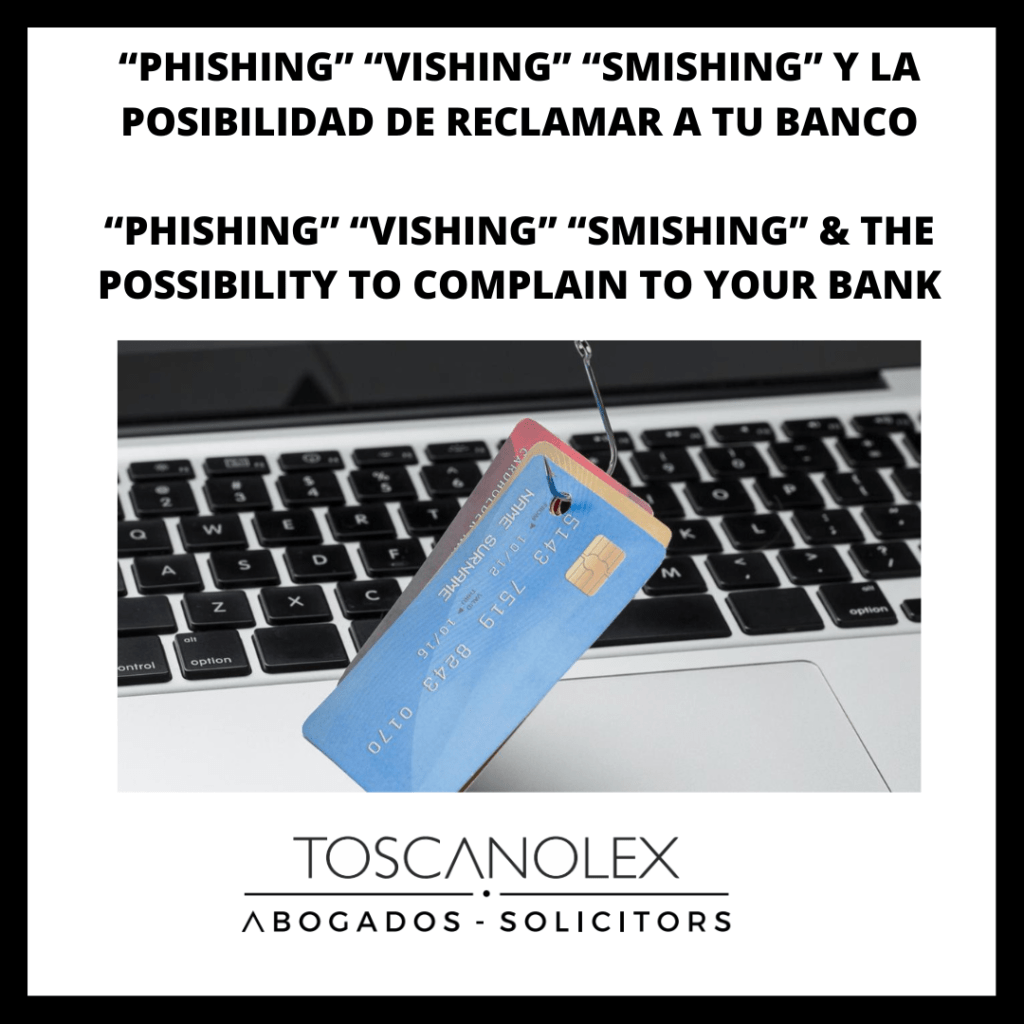‘PHISHING’ ‘VISHING’ ‘SMISHING’. Y LA POSIBILIDAD DE RECLAMAR A TU BANCO

Los delitos informáticos están en aumento desde que los banco optaron por digitalizar gran parte de sus servicios. A continuación, te explicamos los más habituales, y algunas características para detectarlos mas fácilmente:
‘PHISHING’ ‘VISHING’ ‘SMISHING’.
El ‘Phishing’ es el más común, y consiste en el envío de correos electrónicos fraudulentos que dirigen a los clientes a páginas webs falsas que aparentan ser de la entidad bancaria, y a continuación te solicitan los números de la tarjeta de crédito, DNI, contraseña de banca online, e incluso el código CVV.
El ‘Vishing’ ocurre después de haberte robado información a través del ‘Phishing’; el ciberdelincuente te contacta telefónicamente diciéndote que se ha detectado una actividad sospechosa y que puedes perder todo tu dinero, y para evitarlo necesita que le mandes la clave SMS que llega a tu teléfono móvil.
El ‘Smishing’ se utiliza para engañar a los clientes a través de mensajes de texto o mensajes de WhatsApp en el que se hacen pasar por el banco y te dicen que se ha realizado una compra sospechosa con tu tarjeta de crédito, y que es necesario que te comuniques con la banca por teléfono con un numero falso.
Tras la normativa del RD Ley 19/2018, de 23 de noviembre se obliga al banco a restituir los importes defraudados salvo que haya habido fraude o negligencia grave del cliente al utilizar el instrumento de pago.
Desde Toscanolex podemos prestarte asesoramiento legal si has sido victima de un phishing, smishing, o cualquier estafa bancaria, analizando la viabilidad de su reclamación ante su banco y ante los Juzgados y Tribunales de Justicia.
PHISHING’ ‘VISHING’ ‘SMISHING’;AND THE POSSIBILITY TO COMPLAIN TO YOUR BANK
Cybercrime has been on the rise since banks opted to digitise a large part of their services. Here, we explain the most common ones, and some characteristics to detect them more easily:
Phishing’ is the most common, and consists of sending fraudulent e-mails that direct customers to fake websites that appear to be from the bank, and then ask for credit card numbers, ID number, online banking password, and even the CVV code.
Vishing occurs after your information has been stolen through phishing; the cybercriminal contacts you by phone telling you that suspicious activity has been detected and that you may lose all your money, and to avoid this he needs you to send him the SMS code that arrives on your mobile phone.
Smishing‘ is used to trick customers through text messages or WhatsApp messages in which they impersonate the bank and tell you that a suspicious purchase has been made with your credit card, and that you need to contact the bank by phone with a false number.
Following the regulation of RD Law 19/2018 of 23 November, the bank is obliged to reimburse the amounts defrauded unless there has been fraud or gross negligence on the part of the customer when using the payment instrument.
From Toscanolex we can give you legal advice if you have been a victim of phishing, smishing, or any bank scam, analysing the viability of your claim before your bank and before the Courts and Tribunals of Justice.
Search
Categorías
Artículos recientes
- Divorcio Rápido Ante Notario: Caso de Éxito en Ibiza y Málaga
- Proceso de Post Compraventa Guía Completa
- Rescisión de Contrato de Alquiler por Motivos de Urgencia Familiar: Un Caso de Éxito
- La insolvencia punible: Una amenaza al sistema financiero y la justicia para los acreedores
- Acusado falsamente de violencia de género, Caso de éxito






